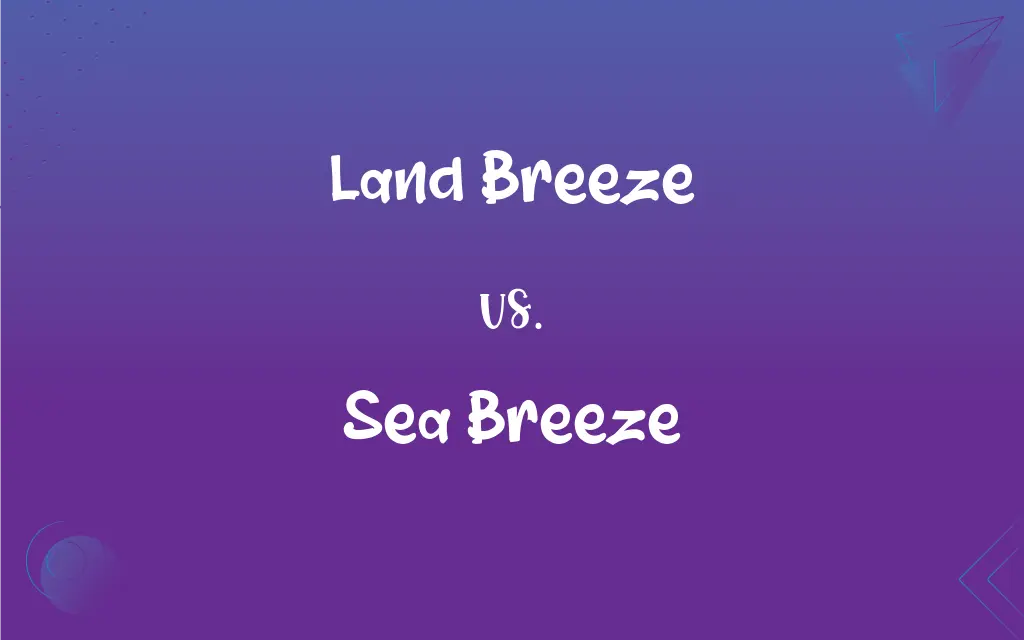Land Breeze vs. Sea Breeze: What's the Difference?
Edited by Aimie Carlson || By Janet White || Updated on October 29, 2023
Land Breeze flows from land to sea during the night, while Sea Breeze flows from sea to land during the day.

Key Differences
Land Breeze and Sea Breeze are natural wind patterns observed along coastlines. While both breezes involve the movement of air between the sea and the land, the timing and direction of these winds differ significantly.
Land Breeze typically forms during the night when the land cools faster than the sea. As a result, cooler air from the land flows towards the warmer sea. In contrast, Sea Breeze takes place during the daytime when the land heats up more quickly than the sea, causing cooler air from the sea to flow towards the warmer land.
The underlying mechanisms behind Land Breeze and Sea Breeze involve temperature differences and atmospheric pressure. For Land Breeze, the land becomes cooler and has higher pressure compared to the sea, pushing the breeze towards the water. On the other hand, with Sea Breeze, the land becomes warmer and has lower pressure, drawing the breeze inland.
These breezes play an essential role in local climate and weather conditions. Land Breeze, flowing during the night, often carries away humidity and can provide relief in coastal areas. Conversely, Sea Breeze, dominant during the day, brings in the moisture and can result in afternoon showers in certain regions.
Though both Land Breeze and Sea Breeze are localized wind patterns, they can significantly impact local temperature, humidity, and even weather phenomena, demonstrating the intricacy of atmospheric interactions.
ADVERTISEMENT
Comparison Chart
Time of Occurrence
Nighttime.
Daytime.
Direction
From land to sea.
From sea to land.
Temperature Relation
Land cooler than sea.
Land warmer than sea.
Resulting Atmospheric Pressure
Higher pressure on land.
Higher pressure over sea.
Effect on Humidity
Reduces humidity on land.
Increases humidity on land.
ADVERTISEMENT
Land Breeze and Sea Breeze Definitions
Land Breeze
A nighttime wind flowing from land towards the sea.
The cool Land Breeze provided relief from the day's heat at the beach.
Sea Breeze
A wind arising from the sea's cooler temperature compared to the land.
The hot sand was bearable thanks to the constant Sea Breeze.
Land Breeze
A nocturnal breeze flowing to balance land-sea temperature disparities.
Sailors anchored close to shore relied on the predictable Land Breeze.
Sea Breeze
A daytime wind flowing from the sea towards the land.
The refreshing Sea Breeze made the beach picnic pleasant.
Land Breeze
Atmospheric flow caused by temperature and pressure differences at night.
As the sun set, the Land Breeze began to sweep across the coastal town.
Sea Breeze
A diurnal breeze resulting from differential heating of land and sea.
Tourists often mistook the midday Sea Breeze for a storm's precursor.
Land Breeze
A wind formed due to land cooling faster than the adjacent sea.
The campers enjoyed the gentle Land Breeze by their seaside campfire.
Sea Breeze
A coastal wind moving landward due to daytime thermal variations.
The fluttering beach umbrellas indicated the onset of the Sea Breeze.
Land Breeze
A coastal wind moving seaward due to nighttime thermal dynamics.
The flags turned seaward, signaling the start of the Land Breeze.
Sea Breeze
Atmospheric flow caused by daytime temperature and pressure contrasts.
With the rising sun, the Sea Breeze began its daily journey inland.
FAQs
Why does Land Breeze flow towards the sea?
Land Breeze flows to the sea due to the cooler land creating a high-pressure zone.
Are Land Breeze and Sea Breeze global phenomena?
They primarily occur in coastal areas where land and sea meet.
When does a Land Breeze typically occur?
A Land Breeze generally occurs during the nighttime.
What drives the formation of a Sea Breeze?
A Sea Breeze is driven by the land heating faster than the sea during the day.
How can one differentiate between Land Breeze and Sea Breeze?
Time and direction: Land Breeze is at night from land to sea, while Sea Breeze is during the day from sea to land.
Does the Sea Breeze always bring cooler temperatures?
Generally, yes, as it carries cooler marine air towards the warmer land.
Do these breezes influence marine activities?
Yes, sailors and fishermen often consider these breezes when planning activities.
Can Sea Breeze affect weather patterns?
Yes, Sea Breeze can lead to increased humidity and even afternoon showers.
Does Land Breeze always cool the coastal areas?
Generally, yes, as it carries cooler land air towards the sea.
Are there places where these breezes don't occur?
They primarily occur in coastal regions; inland areas won't experience them.
Is Land Breeze stronger than Sea Breeze?
Typically, Sea Breeze is stronger due to the more significant temperature difference during the day.
What role does atmospheric pressure play in Sea Breeze?
Sea Breeze forms when the warmer land creates a low-pressure zone, drawing in the cooler sea air.
How do Land Breeze and Sea Breeze affect local climates?
They can regulate temperatures, influence humidity, and even impact local rainfall patterns.
Are these breezes predictable?
They are relatively predictable, often occurring daily in suitable conditions.
Can these breezes affect air quality?
Yes, they can disperse pollutants, improving or worsening local air quality.
Do Land Breeze and Sea Breeze occur in lakes?
Similar breezes can occur near large lakes, termed lake breezes.
Can a Sea Breeze be felt far inland?
It depends on the region, but a Sea Breeze can sometimes be felt many miles inland.
Why is understanding Land Breeze and Sea Breeze important?
They impact weather, local climates, marine activities, and even air quality, so understanding them benefits residents and planners.
Can other factors, like topography, influence Sea Breeze?
Yes, factors like mountains can direct or block the path of a Sea Breeze.
How long does a Sea Breeze last?
It typically lasts throughout the day, diminishing in the evening.
About Author
Written by
Janet WhiteJanet White has been an esteemed writer and blogger for Difference Wiki. Holding a Master's degree in Science and Medical Journalism from the prestigious Boston University, she has consistently demonstrated her expertise and passion for her field. When she's not immersed in her work, Janet relishes her time exercising, delving into a good book, and cherishing moments with friends and family.
Edited by
Aimie CarlsonAimie Carlson, holding a master's degree in English literature, is a fervent English language enthusiast. She lends her writing talents to Difference Wiki, a prominent website that specializes in comparisons, offering readers insightful analyses that both captivate and inform.































































